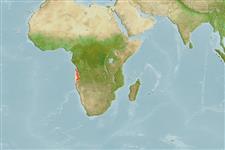Classification / Names
Noms communs | Synonymes | Catalog of Fishes(Genre, Espèce) | ITIS | CoL | WoRMS | Cloffa
>
Scombriformes (Mackerels) >
Caristiidae (Manefishes)
Etymology: Paracaristius: Name from the Greek 'para' meaning around or near and Caristius.; aquilus: Name from Latin aquilus meaning 'dark in color', referring to the black peritoneum..
Environment: milieu / climate zone / depth range / distribution range
Écologie
marin; profondeur 617 - 1480 m (Ref. 87954). Tropical; 25°N - 17°S, 11°E - 18°W (Ref. 87954)
Distribution
Pays | Zones FAO | Écosystèmes | Occurrences | Point map | Introductions | Faunafri
Atlantic Ocean: south east Atlantic, off Angola.
Taille / Poids / Âge
Maturity: Lm ? range ? - ? cm
Max length : 12.9 cm SL mâle / non sexé; (Ref. 87954); 19.2 cm SL (female)
Description synthétique
Morphologie | Morphométrie
Rayons mous dorsaux (Total): 30-33; Rayons mous anaux: 16 - 17; Vertèbres: 35 - 37. This species is distinguished from P. maderensis and P. nudarcus by having fingerlike papillae along the dorsal margin of the hyoid arch and at the interhyal-posterior ceratohyal articulation, as well as having more dorsal-fin rays (30-33 versus 27-31 in P. maderensis and P. nudarcus) and fewer anal-fin rays (15-18 versus 17-20 in the 2 latter species); Paracaristius aquilus differs from P. nemorosus by its lesser body depth (<50% SL in P. aquilus vs. >50% SL in P. nemorosus) and caudal-peduncle depth (relatively long and shallow in P. aquilus vs. short and deep in P. nemorosus) (Ref. 87954).
Life cycle and mating behavior
Maturité | Reproduction | Frai | Œufs | Fécondité | Larves
Stevenson, D.E. and C.P. Kenaley, 2011. Revision of the manefish genus Paracaristius (Teleostei: Percomorpha: Caristiidae), with descriptions of a new genus and three new species. Copeia 2011(3):385-399 (Ref. 87954)
Statut dans la liste rouge de l'IUCN (Ref. 130435)
Menace pour l'homme
Harmless
Utilisations par l'homme
Plus d'informations
PaysZones FAOÉcosystèmesOccurrencesIntroductionsStocksÉcologieRégime alimentaireÉléments du régime alimentaireConsommation alimentaireRation
Noms communsSynonymesMétabolismePrédateursÉcotoxicologieReproductionMaturitéFraiRassemblement de ponteFéconditéŒufsDéveloppement de l'œuf
Taille/ÂgeCroissanceLongueur-poidsLongueur-longueurFréquences de longueursMorphométrieMorphologieLarvesDynamique des populations larvairesRecrutementAbondanceBRUVS
RéférencesAquacultureProfil d'aquacultureSouchesGénétiqueElectrophoresesHéritabilitéPathologiesTraitementNutrientsMass conversion
CollaborateursImagesStamps, Coins Misc.SonsCiguateraVitesseType de nageSurface branchialeOtolithesCerveauxVision
Outils
Articles particuliers
Télécharger en XML
Sources Internet
Estimates based on models
Preferred temperature (Ref.
123201): 3.8 - 5.4, mean 4.2 °C (based on 14 cells).
Phylogenetic diversity index (Ref.
82804): PD
50 = 0.5625 [Uniqueness, from 0.5 = low to 2.0 = high].
Bayesian length-weight: a=0.01995 (0.00906 - 0.04395), b=3.01 (2.83 - 3.19), in cm total length, based on all LWR estimates for this body shape (Ref.
93245).
Niveau trophique (Ref.
69278): 3.6 ±0.5 se; based on size and trophs of closest relatives
Fishing Vulnerability (Ref.
59153): Low vulnerability (13 of 100).
